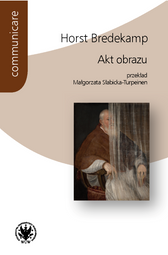Information about a product
| Edition: | 1 |
| Place and year of publication: | Warszawa 2025 |
| Publication language: | polski |
| ISBN/ISSN: | 978-83-235-6754-7 |
| EAN: | 9788323567547 |
| Number of page: | 478 |
| Binding: | Miękka |
| Format: | 17x24 cm |
| Weight: | 775 g |
| Method of publication: | Druk |
| Publication type: | Praca naukowa |
| DOI: | https://doi.org/10.31338/uw.9788323567622 |
Creativity of an Aha! Moment and Mathematics Education
The authors of the publication answer questions about what mathematics has to do with creativity and whether learning mathematics can be creative. In their opinion, maths lessons are an excellent opportunity to shape and explore creativity, and creative aha! moments support the learning process and cognitive development of all students, not only the most talented ones.
The book introduces the theory of bisociation – the creativity of an aha! moment, formulated by Koestler, into the teaching of mathematics. The authors combine it with constructivist concepts of learning, forming the basis of a new theory, which integrates creativity and allows to describe moments of insight at different stages of student development. The texts collected in the publication shed light on the creative experience of eureka in mathematics, which is discussed in various contexts: affection, cognitive processes, attention theory, neuroscience and computational creativity.
Keywords: aha! moment, Koestler’s bisociation theory, constructivist learning concepts, maths didactics, creativity research.
The authors of the publication answer questions about what mathematics has to do with creativity and whether learning mathematics can be creative. In their opinion, maths lessons are an excellent opportunity to shape and explore creativity, and creative aha! moments support the learning process and cognitive development of all students, not only the most talented ones.
The book introduces the theory of bisociation – the creativity of an aha! moment, formulated by Koestler, into the teaching of mathematics. The authors combine it with constructivist concepts of learning, forming the basis of a new theory, which integrates creativity and allows to describe moments of insight at different stages of student development. The texts collected in the publication shed light on the creative experience of eureka in mathematics, which is discussed in various contexts: affection, cognitive processes, attention theory, neuroscience and computational creativity.
Keywords: aha! moment, Koestler’s bisociation theory, constructivist learning concepts, maths didactics, creativity research.
William Baker,
Bisocjacja, kreatywność i interioryzacja
https://doi.org/10.31338/uw.9788323567622.pp.321-340
David Tall,
Budowanie znaczenia w myśleniu matematycznym w dłuższej perspektywie: aha! i uhm!
https://doi.org/10.31338/uw.9788323567622.pp.246-280
Ron Tzur,
Dwuetapowe zmiany w antycypacji: poznawcze źródła momentów aha!
https://doi.org/10.31338/uw.9788323567622.pp.341-364
Bronislaw Czarnocha,
Kolekcja momentów aha!
https://doi.org/10.31338/uw.9788323567622.pp.457-471
Hannes Stoppel,
Benjamin Rott,
Kreatywność w oczach uczniów: przekonania deklarowane i realizowane w projektach matematycznych
https://doi.org/10.31338/uw.9788323567622.pp.225-245
Stephen R. Campbell,
Moment aha! na styku umysłu i mózgu
https://doi.org/10.31338/uw.9788323567622.pp.385-415
Bronislaw Czarnocha,
Peter Liljedahl,
Momenty aha! z perspektywy relacji między poznaniem, afektem i wolicjonalnością
https://doi.org/10.31338/uw.9788323567622.pp.292-320
Gerald A. Goldin,
Momenty aha! z perspektywy wolitywnej
https://doi.org/10.31338/uw.9788323567622.pp.281-291
John Mason,
Bronislaw Czarnocha,
Momenty aha!, bisocjacja i uwaga wieloogniskowa
https://doi.org/10.31338/uw.9788323567622.pp.365-384
Bronislaw Czarnocha,
Nauczanie-badanie: konstruktywistyczny eksperyment nauczający jako metodyka nauczania
https://doi.org/10.31338/uw.9788323567622.pp.81-101
Bronislaw Czarnocha,
Ocena wiedzy nabytej podczas wglądu z momentem aha!
https://doi.org/10.31338/uw.9788323567622.pp.131-158
William Baker,
Olen Dias,
Edme Soho,
Hector Soto,
Lauren Wolf,
Praca zespołu Nauczanie-Badanie (Teaching-Research) z Bronksu: kreatywność
https://doi.org/10.31338/uw.9788323567622.pp.184-224
William Baker,
Rola nauczyciela w promowaniu momentów aha!
https://doi.org/10.31338/uw.9788323567622.pp.159-183
Hannes Stoppel,
Bronislaw Czarnocha,
Struktury bisocjacyjne
https://doi.org/10.31338/uw.9788323567622.pp.416-440
Bronislaw Czarnocha,
Teoria bisocjacji Arthura Koestlera
https://doi.org/10.31338/uw.9788323567622.pp.53-80
Bronislaw Czarnocha,
Wnioski
https://doi.org/10.31338/uw.9788323567622.pp.441-456
Bronislaw Czarnocha,
Wprowadzenie
https://doi.org/10.31338/uw.9788323567622.pp.23-52
Bronislaw Czarnocha,
William Baker,
Wspomaganie wglądów z momentem aha! w klasie
https://doi.org/10.31338/uw.9788323567622.pp.102-130
Bisocjacja, kreatywność i interioryzacja
https://doi.org/10.31338/uw.9788323567622.pp.321-340
David Tall,
Budowanie znaczenia w myśleniu matematycznym w dłuższej perspektywie: aha! i uhm!
https://doi.org/10.31338/uw.9788323567622.pp.246-280
Ron Tzur,
Dwuetapowe zmiany w antycypacji: poznawcze źródła momentów aha!
https://doi.org/10.31338/uw.9788323567622.pp.341-364
Bronislaw Czarnocha,
Kolekcja momentów aha!
https://doi.org/10.31338/uw.9788323567622.pp.457-471
Hannes Stoppel,
Benjamin Rott,
Kreatywność w oczach uczniów: przekonania deklarowane i realizowane w projektach matematycznych
https://doi.org/10.31338/uw.9788323567622.pp.225-245
Stephen R. Campbell,
Moment aha! na styku umysłu i mózgu
https://doi.org/10.31338/uw.9788323567622.pp.385-415
Bronislaw Czarnocha,
Peter Liljedahl,
Momenty aha! z perspektywy relacji między poznaniem, afektem i wolicjonalnością
https://doi.org/10.31338/uw.9788323567622.pp.292-320
Gerald A. Goldin,
Momenty aha! z perspektywy wolitywnej
https://doi.org/10.31338/uw.9788323567622.pp.281-291
John Mason,
Bronislaw Czarnocha,
Momenty aha!, bisocjacja i uwaga wieloogniskowa
https://doi.org/10.31338/uw.9788323567622.pp.365-384
Bronislaw Czarnocha,
Nauczanie-badanie: konstruktywistyczny eksperyment nauczający jako metodyka nauczania
https://doi.org/10.31338/uw.9788323567622.pp.81-101
Bronislaw Czarnocha,
Ocena wiedzy nabytej podczas wglądu z momentem aha!
https://doi.org/10.31338/uw.9788323567622.pp.131-158
William Baker,
Olen Dias,
Edme Soho,
Hector Soto,
Lauren Wolf,
Praca zespołu Nauczanie-Badanie (Teaching-Research) z Bronksu: kreatywność
https://doi.org/10.31338/uw.9788323567622.pp.184-224
William Baker,
Rola nauczyciela w promowaniu momentów aha!
https://doi.org/10.31338/uw.9788323567622.pp.159-183
Hannes Stoppel,
Bronislaw Czarnocha,
Struktury bisocjacyjne
https://doi.org/10.31338/uw.9788323567622.pp.416-440
Bronislaw Czarnocha,
Teoria bisocjacji Arthura Koestlera
https://doi.org/10.31338/uw.9788323567622.pp.53-80
Bronislaw Czarnocha,
Wnioski
https://doi.org/10.31338/uw.9788323567622.pp.441-456
Bronislaw Czarnocha,
Wprowadzenie
https://doi.org/10.31338/uw.9788323567622.pp.23-52
Bronislaw Czarnocha,
William Baker,
Wspomaganie wglądów z momentem aha! w klasie
https://doi.org/10.31338/uw.9788323567622.pp.102-130
Zobacz również
Polecane



Akt obrazu67,00 zł
60,30 zł
Details
- The first Polish translation of the "Image Acts", written by Horst Bredekamp, professor at the Humboldt University of Berlin, an art historian specialising in the theory of the image, political iconology and scientific imagery. In the publication

Matematyka współczesna dla myślących laików31,00 zł
27,90 zł
Details
- A collection of essays popularizing modern mathematics in a simple and accessible way for non-specialists. The author has presented a number of selected, relevant mathematical problems and the results of the research conducted on the topic. Reading

Przekład PJM dla początkujących w teorii i praktyce46,00 zł
41,40 zł
Details
- The multi-author monograph dedicated to the issues of interpreting Polish Sign Language (PJM) contains thirteen articles addressing the subjects which have not been raised before in the debate on the interpreting of the PJM. It discusses the challenges









